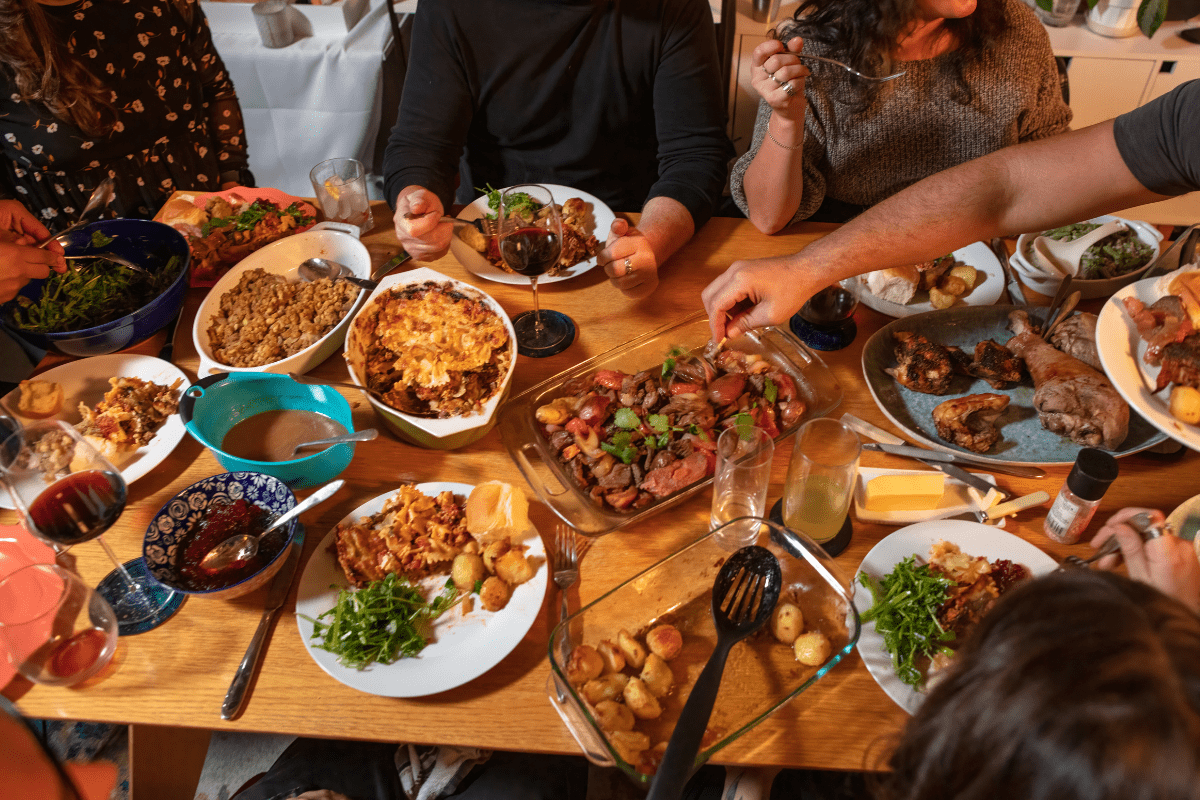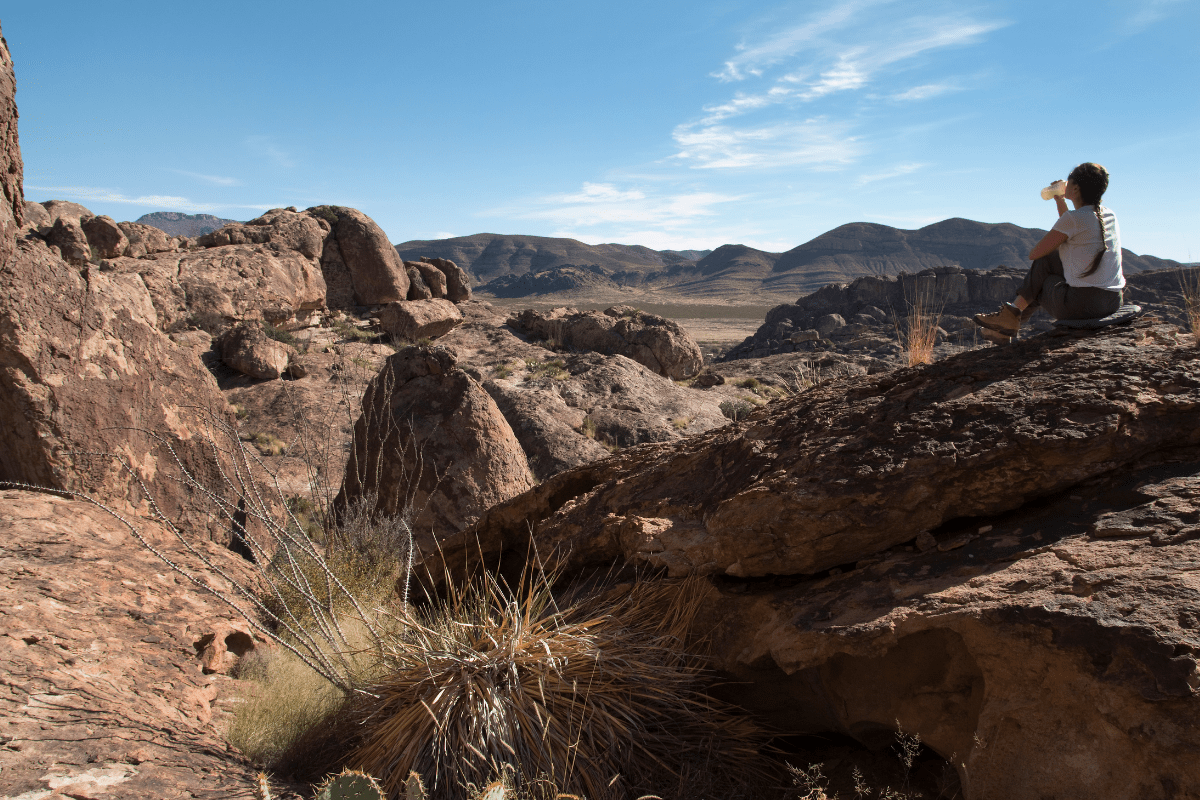Texas doesn't do subtle when it comes to food. In a state where arguments over brisket can end friendships and breakfast tacos are considered a food group, culinary traditions run deeper than oil wells. From German meat markets that birthed modern barbecue to Vietnamese crawfish boils that somehow make perfect sense in Houston, Texas cuisine tells the story of what happens when cultures collide over dinner.
The economic powerhouse hiding in your local taco joint
Texas food isn't just about flavor—it's serious business. The state's food industry generates $106.8 billion annually, employing 1.46 million people across 56,739 restaurant locations. That's more workers than any other private sector in the state, which explains why your cousin, your neighbor, and probably half your high school class have all worked in restaurants at some point.
What really gets interesting is how food tourism drives the economy. About 34% of Texas visitors specifically seek out food experiences, contributing significantly to the state's $94.8 billion tourism industry. People literally plan entire vacations around eating their way through Texas, and honestly, who can blame them?
The devotion goes beyond dollars and cents though. Customers routinely camp overnight for Saturday-only barbecue joints, and fierce debates rage over whether beans belong in chili (spoiler alert: according to state law, they absolutely do not). This isn't just food; it's identity served on a paper plate.
Texas barbecue: Where smoke signals mean dinner's ready
Understanding Texas barbecue means understanding that there isn't just one Texas barbecue—there are four distinct regional styles, each with its own story and stubborn defenders.
Central Texas style: The minimalist's dream
Central Texas barbecue is what happens when German efficiency meets Texas beef. Born in meat markets along the old Chisholm Trail, this style treats seasoning like a suggestion rather than a requirement. Salt, pepper, and post oak smoke do all the heavy lifting, transforming tough cuts over 16-18 hours at a steady 225-250°F.
The holy "Texas Trinity" emerges from offset smokers wrapped in butcher paper: brisket, pork ribs, and sausage. No sauce needed, thank you very much. As Aaron Franklin explains, "Barbecue has never been a rich man's pleasure. The fact that in Texas barbecue, you're taking one of the worst pieces of the animal and converting it into one of the best is a miracle itself."
At Louie Mueller Barbecue in Taylor, three generations have maintained this tradition since 1949. Their secret? A seemingly insane 9:1 black pepper to salt ratio that would make your cardiologist weep but your taste buds sing. The crusty exterior, known as "bark," provides textural contrast to the tender meat within, creating what many consider the perfect bite.
East Texas style: Sweet, saucy, and soulful
Travel east and everything changes. Here, African American pitmasters brought smoking traditions from the Southeast, creating a style where sauce isn't sacrilege—it's essential. Sweet tomato-based concoctions coat meat that falls off the bone, a technique perfected by generations of Black cooks who transformed unwanted cuts into sought-after delicacies.
The region's signature hot links represent pure Texas innovation. These spicy beef sausages, often baked rather than smoked, remain hyperlocal specialties that rarely travel beyond county lines. Each small-town meat market guards its recipe like a state secret, creating a hot link trail that rewards adventurous eaters.
South Texas and West Texas: Desert adaptations
South Texas brings Mexican influences through barbacoa, traditionally cooked in underground pits lined with mesquite coals. Vera's Backyard Bar-B-Que in Brownsville maintains the only commercial operation still using authentic underground methods for cooking whole cow heads. It's a weekend ritual that turns Sunday mornings into celebrations.
Out west, where trees are scarce and mesquite is king, cowboys developed a direct-grilling style that produces intense wood flavor in shorter cooking times. When you're feeding a crew on the open range, you can't wait 18 hours for brisket. This high-heat method creates a completely different but equally valid barbecue experience.
Tex-Mex: The delicious identity crisis
Tex-Mex cuisine exists in that sweet spot between authenticity and adaptation, and Texans wouldn't have it any other way. This fusion began after Texas statehood in 1845, when Tejano cooks started modifying traditional recipes for Anglo customers who had different tastes and access to different ingredients.
The changes seem small but matter enormously:
- Yellow cheese replaced white
- Beef dominated over pork
- Flour tortillas gained ground
- Cumin became the dominant spice
- Portion sizes grew considerably
- Combination plates became standard
The billion-dollar fajita revolution
Nothing illustrates Tex-Mex innovation better than fajitas. South Texas vaqueros originally grilled skirt steak—the "faja" or belt of meat—over mesquite fires as part of their payment. This throwaway cut would become a billion-dollar phenomenon.
Ninfa Rodríguez Laurenzo changed everything in 1973 when she borrowed $2,000 to convert her failing tortilla factory into a restaurant. Her "tacos al carbon" featured sizzling platters of grilled meat with onions and peppers, creating theater as much as dinner. By 1977, Texas Monthly noted that "no other Texas restaurant dictates the dining-out habits of so many of its city's inhabitants."
Today, fajitas appear on menus worldwide, but they'll never taste quite right without that hint of mesquite smoke and the confidence that comes from knowing you're eating the original.
Breakfast tacos: Democracy wrapped in a tortilla
If Texas had a state breakfast (and honestly, it should), breakfast tacos would win by a landslide. These handheld miracles appear everywhere from gas stations to boutique brunch spots, proving that good food transcends economic boundaries.
The formula stays simple: warm flour tortilla, scrambled eggs, and whatever else your heart desires. Popular combinations include bacon and egg, chorizo and egg, potato and egg, or the ultimate indulgence—all of the above. San Antonio and Austin both claim to have invented them, but the real winners are the millions who start their mornings with this portable perfection.
When Germans and Czechs decided to stay for dinner
The failed European revolutions of 1848 sent waves of Germans and Czechs to Texas, and thank goodness they brought their recipes. By 1850, Germans made up over 5% of the Texas population, establishing the "German Belt" from Galveston through the Hill Country.
The German barbecue revolution
These immigrants didn't just adapt to Texas; they fundamentally transformed it. German butchers fell in love with Texas beef, establishing meat markets that would become the template for modern barbecue joints. They brought precise smoking techniques and, crucially, the idea that great meat doesn't need sauce to hide behind.
Food historian Robb Walsh notes how Germans "fell hard for the romance of Texas beef, setting up the premier meat markets and turning themselves into such superb barbecue pitmasters that sauce was beside the point." This philosophy—letting quality ingredients speak for themselves—remains central to Texas barbecue culture.
German influence extends beyond the smokehouse. That chicken fried steak smothered in cream gravy? It's schnitzel's Texan cousin, born when German immigrants pounded tough round steak thin, coated it in seasoned flour, and pan-fried it to golden perfection. It's comfort food that crosses all cultural lines.
Czech kolaches conquer Texas
Czech immigrants concentrated in Central Texas, with towns like West (yes, that's the town's name, and no, it's not in West Texas) becoming kolache central. The state legislature even declared West the "Home of the Official Kolache," because Texas takes its pastries seriously.
Traditional kolaches are sweet yeast dough pastries filled with fruit preserves, but Texas Czechs created something new: the klobasnek. This savory version wraps the same dough around sausage, creating the perfect road trip food. Texans stubbornly call both versions "kolaches," much to the horror of Czech purists.
These breakfast staples now account for one-third of sales at Texas donut shops. The Czech Stop bakery on I-35 serves thousands daily, becoming as much a destination as a convenience. Nothing says "Texas road trip" quite like a warm kolache and a Dr Pepper at 7 a.m.
Regional flavors: Because Texas is basically five states pretending to be one
Texas covers 268,000 square miles, creating distinct culinary regions shaped by geography, immigration, and sheer stubbornness.
East Texas: Where the South meets Texas
East Texas, with its pine forests and proximity to Louisiana, developed a soul food tradition that stands apart from the rest of the state. Here, fried catfish reigns supreme, served alongside cornbread, collard greens, and sweet tea so sugary it could double as dessert.
The region's famous hot links deserve their own pilgrimage. These spicy beef sausages, often baked rather than smoked, vary from town to town. Each small meat market guards its recipe jealously, creating a hot link trail that rewards dedicated eaters. Some are mild enough for children; others require a fire extinguisher on standby.
Rio Grande Valley: Breakfast taco paradise
The Valley operates on its own culinary wavelength. Here, massive flour tortillas the size of hubcaps envelop machacado con huevo (dried beef with scrambled eggs), barbacoa, and fresh salsas that would make other regions weep with envy.
The region's $300 million citrus industry adds unexpected flavors to local dishes. Grapefruit and orange notes appear in marinades and salsas, creating brightness that cuts through rich meats. Sunday morning barbacoa, made from slow-cooked cow heads, brings families together for a tradition that predates Texas itself.
West Texas: Where cowboys meet creativity
West Texas forced innovation through scarcity. Chuck wagon cooks perfected Dutch oven techniques that could produce biscuits, stews, and cobblers using minimal resources. These recipes, born from necessity, created a cuisine that could survive temperature extremes and weeks on the trail.
Modern West Texas surprises visitors. Towns like Marfa, once known mainly for mysterious lights, now host James Beard-nominated restaurants. It's surreal to find cutting-edge cuisine in places where finding any restaurant used to be the challenge. This juxtaposition—sophisticated food in the middle of nowhere—perfectly captures modern Texas.
Gulf Coast: Where cultures keep mixing
The Gulf Coast writes new chapters in Texas's culinary story daily. Houston's massive Vietnamese population created an unlikely fusion: Vietnamese-Cajun crawfish. Boiled mudbugs get tossed in garlic butter infused with lemongrass, ginger, and enough spice to make you question your life choices (in the best way).
The coast provides 90 million pounds of shrimp annually, fueling everything from food trucks to fine dining. Galveston's historic oyster houses serve bivalves that taste like the Gulf itself, while Port Aransas delivers fresh red snapper that makes inland dwellers consider relocating.
The new Texas: Innovation meets tradition
Texas cuisine refuses to stand still. The state hosts 549 food trucks, second only to California, serving everything from Korean BBQ tacos to gourmet donuts that would make your dentist cry. Ghost kitchens grow at 85% annually, while 90% of diners still prefer physical menus over QR codes—because some things shouldn't change.
Young pitmasters experiment with coffee-ground rubs and Asian-inspired glazes, while 89-year-old Tootsie Tomanetz at Snow's BBQ still gauges temperature by touching hot metal with her palm. "As long as God gives me a clear mind and a working body, I will continue," she says, representing the determination that defines Texas food culture.
The farm-to-table movement thrives, with Texas schools spending $257.8 million on local foods—a 70% increase since 2019. This isn't just trendy; it's practical. When your state produces everything from beef to citrus, local sourcing makes sense.
Craft beer finally catches up
Texas craft breweries produce 1.369 million barrels annually, creating beers specifically designed to complement bold Texas flavors. Hoppy IPAs cut through fatty brisket, while Mexican lagers cool the burn of spicy salsas. Despite recent industry consolidation, innovation continues, with breweries experimenting with everything from prickly pear to jalapeño infusions.
Recognition arrives
Texas cities finally receive the culinary recognition they deserve. Michelin guides expand into Texas, James Beard Awards regularly honor Texas chefs, and food media can't ignore the state's influence anymore. Dean Fearing, often called the "Father of Southwestern Cuisine," reflects on the movement he helped start: "It was about using products indigenous to our area in Texas, such as fish and shrimp from the Gulf and meat from West Texas."
The future tastes like Texas
Texas faces challenges—drought pushes cattle numbers to historic lows, beef prices rise 4.2% yearly, and only 52% of restaurants report adequate staffing. Yet optimism prevails. The industry employs 11% of the state's workforce and continues growing.
Demographics drive change. As Houston chef Hugo Ortega observes, "Look behind the kitchen doors at the hot spots. The finest kitchens are more likely staffed with Mexican immigrants than with budding new chefs. The Hispanic population is already the backbone of the Texas food scene." This reality, combined with continued immigration from Asia, Africa, and Latin America, ensures Texas cuisine will keep evolving.
African American pitmasters finally receive overdue recognition for their foundational contributions. Women break barriers in traditionally male-dominated smokehouses. Each generation adds new flavors while respecting what came before.
Why Texas food matters
Texas cuisine demonstrates how food preserves identity while building bridges. Every tradition—from Tejano tortillas to German sausages, Czech kolaches to African American barbecue techniques—adds threads to a distinctly Texan tapestry.
Whether it's an 18-hour brisket that requires patience and skill or a breakfast taco assembled in 30 seconds at a gas station, Texas food embodies the state's character: bold, unapologetic, and absolutely convinced of its own excellence. That confidence isn't misplaced. When you create cuisine that makes people plan vacations around meals, camp overnight for barbecue, and argue passionately about beans in chili, you've transcended mere food.
You've created culture. And in Texas, that culture tastes like smoke, spice, and the absolute certainty that whatever you're eating, it's the best version in the world.





